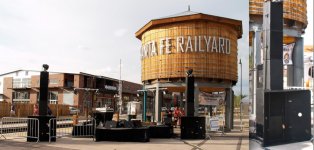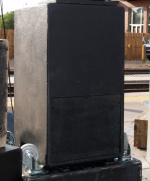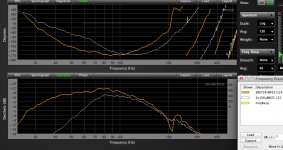Brian,I'm pretty happy with my iNuke 3000DSP as well.
You'd be 3dB happier with the output of the bridged NU4-6000
Art
Brian,
You'd be 3dB happier with the output of the bridged NU4-6000.
Art
I'd considered going with one of the non-DSP amps, but decided to opt for the DSP functions of the iNuke 3000DSP instead. They really have come in handy.
I'm considering purchasing another NU3000DSP myself. The only complaint I can level at it is that when running right up to the limits it likes to turn off. Other than that it's a fantastically cheap piece of equipment for what it does.
I think that highlights what the difference is between the budget amps and the big dogs, We've all heard the stories of 5000VZs getting hammered all night with a bridged 1 ohm load, they will keep pumping as long as you can keep them from melting down.
My experience with the iNukes would be the NU6000 powering a pair of SRX728s outside in August for 12 hours a day for three days, it never missed a beat.
@Art My iTech was being pushed about 10 dB past the onset of the clip light, I don't think there is a louder fan than the one of the iTechs.
Hey Spenser, that's living large!
Coincidentally, I was just doing amplifier comparisons yesterday using my BC18SW115-4 loaded Keystones.
Did tests with full tilt pink noise (and +3 dB and +6dB past clip/limit light onset) and 35 Hz full power sine wave tests using a single channel of a Behringer NU-4000 driving one and two cabinets, (with the other three channels driving either 4 or 2 ohm loads), a bridged mono Crest CA9, and finally a bridged mono QSC PLX3600.
As Bonnie expressed her complaints regarding the noise (the speaker's LF output is loud enough to annoy anyone, but the noise of the flapping corrugated tin of the shop wall puts it way over the top) when she returned from work, I wrapped things up, but when emerging from the heated portion of the shop noticed the terrible smell of cooking epoxy surrounding the indoor (dummy load) and outdoor (SPL test) speakers.
I plan to get back to more amp testing now, hope my BC18SW115-4 are not also "mooing" like yours.
If they are, may to have to pay some air freight to get them reconed in time for the sale of my complete large system. Would be kind of ironic if, after years of use, I burnt them testing just days before the sale.
The NU-4000 handled full tilt 2 ohm 35 Hz sine wave testing, all 4 channels driven under load with no shutdowns for as long as I cared to leave the Keystone connected, about 10 seconds, then I continued to let it cook load resistors on the other 3 channels for another 30 seconds or so. Even after that, the output from the fans seemed barely warmer than the room, but I burnt my fingers testing one of the 2 ohm load resisters made from a brick wrapped with about 75 feet of baling wire.
The QSC PLX3600 on the other hand, drew about double the wall power, and put out heat like a hair dryer on "high".
If I have not roached the Keystones, I'll be testing the NU-4000 with a pair of channels bridged mono, after I understand how to wire the Speakon connectors for bridged operation.
So far the only things I'm not loving about the NU-4000 is it's lack of anything other than Speakon outputs (had to make a lot of adapters to hook up speakers and load resisters), and the fan noise, which is far louder than any other amps in the test, even at idle they are about twice as loud as the shop heater fan. Judging by the heat output, there is no reason they should be that loud, a Crest CC2800 (next in line for testing) has the same size fans and is almost inaudible (even with one of the fans missing two blades after a screwdriver mishap) at idle.
Art
Are just downsizing or are you going to replace the keystones?
Art, if you havn't done the test already, would you care to try to connect two keystones to one bridged side of the NU4-6000 and see how it plays? If the amp would be able to give four keystones a good ride without popping the breakers it would be very well spent 400$.. 
I had a Peavey IPR1600 which was incredible for what it did, at a given voltage it sounded "louder" than the toroid amps(much more powerful on paper) I compared it to at the same voltage... I guess it has to do with efficiency and it blew cool air even after 12 hours of really heavy use with DDT lights flashing almost always, without sounding distressed at all. Then when it was connected to a true sine generator it stopped working of some reason unfortunately.

I had a Peavey IPR1600 which was incredible for what it did, at a given voltage it sounded "louder" than the toroid amps(much more powerful on paper) I compared it to at the same voltage... I guess it has to do with efficiency and it blew cool air even after 12 hours of really heavy use with DDT lights flashing almost always, without sounding distressed at all. Then when it was connected to a true sine generator it stopped working of some reason unfortunately.
I have an IPR1600 and while it was slightly less powerful than I would have thought, it does blow cold to lukewarm air. It would be useful to put a Kill-A-Watt meter on it to see what it used at varying volume levels. 1000 watt amp on everyday music should average only 100-200 watts at clip. I went to see a guy with a full Bill Fitzmaurice rig with 2-3 Peavey digital amplifiers and I think he said it was between 600-700 watt average power consumption on full blast music at ear splitting levels. That's not even 4 amp draw!
I haven't tried extended sine waves though, as they tend to heat up speakers a lot more than general music!
I haven't tried extended sine waves though, as they tend to heat up speakers a lot more than general music!
Last edited:
My Keystones are loaded with 4 ohm drivers, so I will try one on each bridged mono pair. With four channels each loaded with two ohms, driven to the limit light with 30-100 Hz pink noise it drew up to 11.5 amps (120volt) 100-9000 Hz it rew 9 amps. With 35 Hz sine wave, 21 amps. Long term, the amps breaker would pop, but I was surprised it didn't during the fairly long time I let the sine wave signal go.Art, if you havn't done the test already, would you care to try to connect two keystones to one bridged side of the NU4-6000 and see how it plays? If the amp would be able to give four keystones a good ride without popping the breakers it would be very well spent 400$..
Judging by the tests I have already done, it looks like the NU4-6000 is going to be within a dB of amps that cost (and weigh) 2-3 more, and have twice the channels.
My Keystones are loaded with 4 ohm drivers, so I will try one on each bridged mono pair. With four channels each loaded with two ohms, driven to the limit light with 30-100 Hz pink noise it drew up to 11.5 amps (120volt) 100-9000 Hz it rew 9 amps. With 35 Hz sine wave, 21 amps. Long term, the amps breaker would pop, but I was surprised it didn't during the fairly long time I let the sine wave signal go.
Judging by the tests I have already done, it looks like the NU4-6000 is going to be within a dB of amps that cost (and weigh) 2-3 more, and have twice the channels.
I'm sorry about my lack of electrical knowledge, but if I have 230V would it be about half the amperage drawn compared to 120v? It will be interesting to hear your conclusions if the Bridged amp are capable of driving the 115 to full performance.
Thanks
Downsizing, selling my largest system complete with the Keystones, retaining a smaller system that has a pair of the new SynTripP cabinets and a pair of 2x15" PPSL subs, that pair of subs are the size of one Keystone.Are just downsizing or are you going to replace the keystones?
I still have the Domino DFLH system (powered by some older amplifiers..)with four top cabinets and a nifty little 10" tapped horn for sale (cheap, like less than component cost).
Art
Attachments
I still have the Domino DFLH system (powered by some older amplifiers..)with four top cabinets and a nifty little 10" tapped horn for sale (cheap, like less than component cost).
Art
A 10" PA TH? Would love to see the design notes on that.
I'll be finishing the amplifier tests today.I'm sorry about my lack of electrical knowledge, but if I have 230V would it be about half the amperage drawn compared to 120v? It will be interesting to hear your conclusions if the Bridged amp are capable of driving the 115 to full performance.
120(volts)x21(amperes)=2520 watts. If the NU-4 6000 is 90% efficient (just a guess, I should have measured the output voltage during the sine wave test) it would be putting out 2268 watts/4 channels/2 ohms, about 567 per channel, so a mono bridged pair should do around 1134 watts in to 4 ohms. With sine waves (or certain genres of music that has similar 3 dB crest factor in the sub 100 Hz range), that may be enough power to char a BC18SW115-4 after not too long a time.
The stink from the (over) heated BC18SW115-4 voice coil epoxy lingered in the shop for several days after the last sine wave tests. I did verify all 28 drivers used in the tests are still working perfectly, though upon first listening thought I'd had lost 7 out of 8 HF drivers, fortunately it turned out to be a oxidized connection on the first link cord.
2520 (watts)/230 (volts)=10.96 amps, just over half the amperage needed for 120 volt operations. I envy the European power, I could cut my AC cable weight in half if 230 vac was available from the usual household outlets.
Even though the NU-4 6000 is super efficient, it still sucks power like crazy on peaks, ideally you should size your 230 vac cable for 29 amp (peak) draw with no more than 5% voltage drop for whatever length you are running. At 120 volts, ideally we would size the cable for a 55 amp peak draw!
That size cable is too heavy for me to lug around, so I will live with some voltage drop and reduced peak power output...
Art
Last edited:
I'll be finishing the amplifier tests today.
120(volts)x21(amperes)=2520 watts. If the NU-4 6000 is 90% efficient (just a guess, I should have measured the output voltage during the sine wave test) it would be putting out 2268 watts/4 channels/2 ohms, about 567 per channel, so a mono bridged pair should do around 1134 watts in to 4 ohms. With sine waves (or certain genres of music that has similar 3 dB crest factor in the sub 100 Hz range), that may be enough power to char a BC18SW115-4 after not too long a time.
The stink from the (over) heated BC18SW115-4 voice coil epoxy lingered in the shop for several days after the last sine wave tests. I did verify all 28 drivers used in the tests are still working perfectly, though upon first listening thought I'd had lost 7 out of 8 HF drivers, fortunately it turned out to be a oxidized connection on the first link cord.
2520 (watts)/230 (volts)=10.96 amps, just over half the amperage needed for 120 volt operations. I envy the European power, I could cut my AC cable weight in half if 230 vac was available from the usual household outlets.
Even though the NU-4 6000 is super efficient, it still sucks power like crazy on peaks, ideally you should size your 230 vac cable for 29 amp (peak) draw with no more than 5% voltage drop for whatever length you are running. At 120 volts, ideally we would size the cable for a 55 amp peak draw!
That size cable is too heavy for me to lug around, so I will live with some voltage drop and reduced peak power output...
Art
That's what I was searching for in manuals and such, the capability of the ac inlet of an amp tells a lot about it and in the nu-4 6000 it is 12 ampere in the EU version so it sounds like the power stage and amplifier stage are well optimized for each other. Thanks for your detailed explanation and I'm looking forward to your conclusions in your test!
A 10" PA TH? Would love to see the design notes on that.
Have you seen the THAM10?
Have you seen the THAM10?
Yup. I'd like to see if Art came up with something different.
I did try out a THAM-type fold with a 12" driver. I prefer the SS type fold for a number of reasons.
What are your reasons?
1. Panel flex: The larger the panels, the greater the tendency to flex, and the greater the bracing requirements to minimize this. The THAM design places some of the largest panels near the points of greatest pressure (e.g. at S1). In the SS fold, the shortest panels are located at S1.
2. Geometry/Design Flexibility: The THAM design results in a box with a roughly square cross-section if the taper is done properly, and it's not easy to implement a dual-taper design with this fold. The SS fold offers a lot more flexibility wrt dimensions and it's actually quite easy to do a dual-taper design with it.
The THAM fold has one advantage - the area of the box around the mouth is more reinforced than is the case with the SS fold. But this can be addressed in an SS fold if it really is an issue by diagonal cross-bracing across the mouth.
Different, but similar to the Keystone, you can see it in post #55:Yup. I'd like to see if Art came up with something different.
http://www.diyaudio.com/forums/subwoofers/216701-midbass-tapped-horns-6.html
The chart below is the response of the 2x10" compared to a JBL SRX 728 dual 18" cabinet, both with 25/125 BW24 filters.
Attachments
- Home
- Loudspeakers
- Subwoofers
- Keystone Sub Using 18, 15, & 12 Inch Speakers


